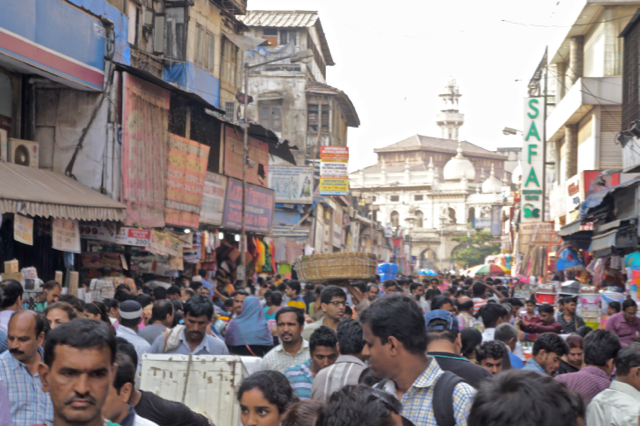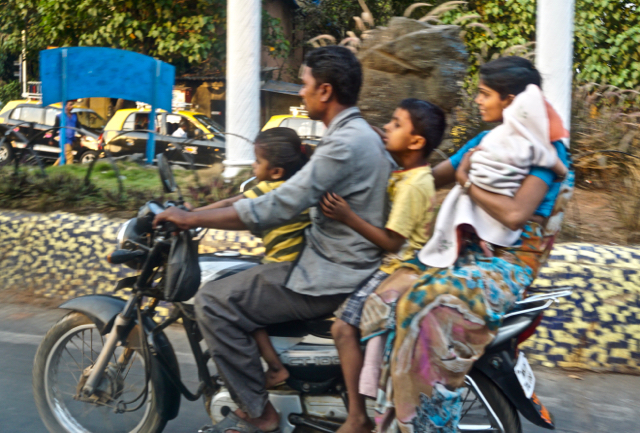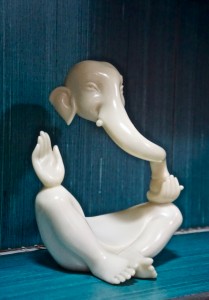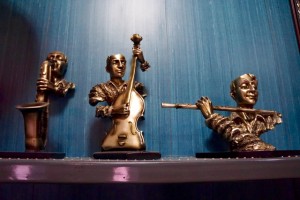Mumbai: India's New York City
April, 2016

We have been very blessed to be hosted on this trip by our dear friend Lajo Gupta, first at her home in Dubai, and afterwards in Mumbai, where she flew to host us in her wonderful apartment there. I met Lajo forty years ago(!) when I first started studying Indian classical music at her illustrious father’s college in California, the Ali Akbar College of Music in Marin County, California.
Mumbai is a city with an estimated twenty million inhabitants. No exact number exists. Refugees from the Indian countryside flock to Mumbai in search of work. They create housing out of just sheet metal, cardboard, canvas sheets, discarded lumber…anything to provide shelter. The result is one of the largest urban slum areas in the world. They were the backdrop for the Oscar-winning film Slumdog Millionaire, shot mostly in Mumbai. Traffic is horrendous. Roads are inadequate for the number of cars. Poor people, whole families, can be seen, living beside the city streets in their makeshift shelters.


The previous paragraph might give the impression that Mumbai is a horrendous metropolis with no redeeming features. Au contraire…the wonderful people and the great culture make Mumbai my favorite destination in India, a city that I’ve visited more than any other. I have some great friends here, and this year’s visit has resulted in more new friends and experiences.

I’ve usually visited India during the winter months of January and February. Here at the end of March, the weather is hotter (in the 90’s-F/35-C). But mango season is starting, and a fresh mango lassi (a refreshing fruit+yogurt drink) is one of life’s great gastronomic pleasures.

Perhaps the most stunning aspect of Mumbai (and India in general) is the clearly visible rich and poor existing very close to each other. In the US, a millionaire might wear jeans and be otherwise indistinguishable from the average person. In India, it’s relatively easy to assess the economic standing and religion of people on the street, based on their clothing. Traditional Hindu women wear saris. Traditional Moslem women wear abayas/chadors (scarves or veils). Sikh men wear turbans, mostly black, though often other colors. Moslem men wear mostly white turbans, but tied differently from the Sikh turbans. Middle class men and women are harder to stereotype, because they wear non-descript Western suits and dresses. The richest Indians drive Mercedes and BMWs. The middle class drive a variety of Indian-made and imported small vehicles. The poor will never own any car in their lives.
India is a contradictory blend of modern and traditional. Susan and I regularly used Uber for our transport instead of regular taxis. Choosing the slightly more expensive Uber-black, the car had a full wi-fi internet available. Meanwhile, the newspapers carry all-to-regular reports of “honor killings”, in which family members kill a daughter who dares to marry for love outside her caste or religion. In this shameful practice, the traditional Hindus don’t seem to be any better than the traditional Moslems, who are more commonly associated with this despicable practice in neighboring countries dominated by the Moslem religion.


But there’s no reason for us Americans to feel superior. Less than a hundred years ago, my Southern countrymen would gather in the park, eat fried chicken, and pose for photos by the hanging immolated bodies of the poor tortured black men who had been lynched simply for committing some offense, such as looking at or “whistling at” a Southern white woman. Christians have a sordid history very similar to current ISIS Moslems in how Christians treated native Americans and African slaves.
India is a country of over a billion people. It will eventually surpass China as the world’s most populous nation. Approximately ten percent of the population is Moslem. That means there are more Moslems in Hindu-majority India than in neighboring exclusively Moslem Pakistan. Currently, these two main Indian religions coexist mostly peaceably. Unfortunately, the current prime minister, Mahendra Moti, has tacitly encouraged his fundamentalist Hindu supporters, by not speaking out against their actions to destroy mosques and generally oppress Moslems. There is an uproar in the (mostly free) press concerning government actions against student protestors, who have spoken out against policies of the current government. Free speech and free press in India are thus being suppressed by the government, causing many of India’s most famous writers and intellectuals to come to the defense of the students.

Despite all India’s problems and challenges, it’s a seductively attractive place to visit. Beyond my many friends here (the result of my more than a dozen visits over the years), people in general tend to be very open and friendly. It’s easy to get a smile out of a driver in a cab while sitting in traffic, a shop merchant, or simply a stranger.
India is a shopper’s paradise. The clothing and textiles are among the world’s best and most colorful. Sculptures, carvings, weavings, etc. are plentiful and inexpensive. I’m coming home with many new Indian-style shirts (kurtas). Prices are cheaper, at least by half, than one would pay at home.
The food is incredible. I’ve loved Indian food since my very first visit in 1971. Remember, Spaniard Christopher Columbus discovered America while looking for India. He was looking to find the great curry he had heard about. The glowing reputation of Indian food was known world-wide centuries ago. We ate at simple local vegetarian restaurants serving standard dishes such as South Indian Masala Dosas, in which we knew their food was as good as or probably better than we could have obtained in a five-star hotel.

Lastly, the level of artistry among Mumbai’s musicians is extremely high. The top jazz musicians of India could be right at home in Reno or New York. The Hindustani classical musicians are impressive in their virtuosity. I managed to play three informal concerts within the nine days here, working with incredible musicians, both Indian and foreign.
Because of the people, the friends, the music, the food, the shopping, the history, the rich culture, etc., I plan to return to Mumbai as often as I can.



Above are three artworks from superstar musician Louiz Bank's parlor. Louiz was born into a musical family of Nepali extraction, growing up in Darjeeling. Louiz painted the mountain view from Darjeeling. On the right, an unusual "phantom" rendering of the god Ganesha, thought to bring prosperity and good luck.

We gave, by Indian standards, a generous donation to this poor beggar, evincing his beatific smile. Our hostess thinks that he was purposely disabled and denied healthcare by the mafia that controls an array of street beggars. She would have told us not to give to him, because it perpetuates this perverted system. (She advises giving to reputable agencies that aid the poor.) Remember the scene in the movie Slumdog Millionaire, in which a young boy is purposely blinded in order to be exploited as a beggar? This is the unfortunate reality in modern India.

0 Comments on Mumbai: India's New York City
Join the Conversation